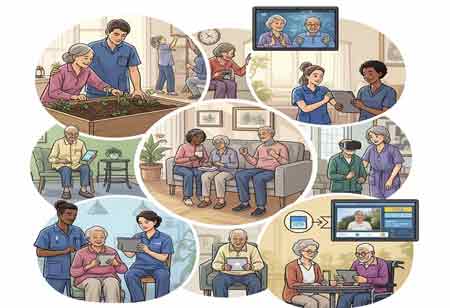Thank you for Subscribing to Eldercare Review Weekly Brief
Meeting the Demands of an Aging Population: The State of Home Care

By
Eldercare Review | Friday, April 11, 2025
Stay ahead of the industry with exclusive feature stories on the top companies, expert insights and the latest news delivered straight to your inbox. Subscribe today.
The home care service sector is expanding rapidly, owing to altering aging population choices, advances in healthcare technology, and an increased desire among seniors to age in place. As families prioritize their loved one's comfort and well-being, the demand for home care services is stronger. However, this burgeoning sector is not without obstacles. Providers must handle rising prices, regulatory changes, and a demand for highly qualified professionals. Despite these obstacles, there are numerous prospects for innovation, mainly through integrating technology and more individualized care models.
Meeting the Growing Need for In-Home Care
The need for in-home care grows, with many seniors preferring to stay in familiar surroundings rather than move to institutional settings. According to numerous industry studies, more than 90% of older persons choose to age at home, making home care an essential service in the eldercare ecosystem. The growing demand for aging in place has compelled home care providers to offer a broader range of services, such as personal care, expert nursing, companionship, and rehabilitation.
Unlike traditional nursing homes or assisted living facilities, home care enables seniors to preserve their independence while receiving the necessary care. This technique improves comfort and decreases the risk of infection, an increasing concern in communal living areas. As families and elders become more aware of the benefits of home care, there is a growing need for care tailored to each individual's specific needs.
However, offering high-quality home care involves several problems. One of the most significant challenges in the sector is ensuring a consistent supply of trained caretakers. Home care providers must handle the industry's ongoing staffing deficit, which frequently pits them against hospitals and nursing homes for a limited pool of competent specialists. Innovative recruitment techniques, retention initiatives, and competitive pay structures are becoming increasingly important for agencies seeking to meet expanding demand.
Overcoming Operational and Financial Barriers
While home care services have numerous advantages, they also present operational and financial obstacles. One of the most serious challenges is the rising cost of services. High-quality care, especially for those with complex medical needs, necessitates experienced experts, specialized technology, and, in some cases, larger staff-to-client ratios. These factors will inevitably raise the overall cost of home care services. As a result, some families struggle to afford continuous care, particularly if long-term care is required.
Furthermore, the reimbursement mechanism for home care services remains complicated and dynamic. Insurance policies, including Medicaid and commercial insurance, frequently do not cover all aspects of in-home care, resulting in out-of-pocket payments. Home care providers are attempting to negotiate these challenges by adopting more open pricing structures and pursuing collaborations with insurers to expand coverage possibilities.
As the demand for home care grows, businesses turn to technology to cut costs and enhance operational efficiency. Telemedicine, remote patient monitoring, and digital care management platforms enable agencies to improve care while decreasing the need for in-person visits. These technologies simplify communication, increase care coordination, and allow caregivers to monitor patients' health remotely, resulting in better outcomes and a more cost-effective service.
Capitalizing on Technological Advancements and Personalized Care
Technology is gradually playing an essential role in revolutionizing the home care business, allowing for higher quality and more efficient care. The integration of wearable gadgets, sensors, and mobile health apps has made it possible to monitor patients' vital signs and ailments in real time. These gadgets notify caregivers and family members of potential problems and provide valuable data that can be utilized to change care plans in real time.
Another notable advance is using artificial intelligence (AI) and machine learning (ML) to improve healthcare delivery. AI-powered platforms can assist in connecting caregivers with customers based on various variables, including personality, care needs, and geographic location. This level of customization guarantees that elders receive care suited not just to their physical needs but also to their emotional preferences, which is essential for overall well-being.
Furthermore, virtual companionship and telehealth services have made it easier for elders to communicate with healthcare specialists and retain social engagement. These programs significantly benefit people who feel isolated or have limited mobility. Home care providers can provide remote consultations and virtual check-ins to ensure seniors receive ongoing support without frequent in-person visits.
Home care organizations are also exploring new ways to personalize services. Many businesses are emphasizing the emotional and social aspects of care in addition to meeting medical needs. Home care providers help seniors maintain their freedom and dignity by providing companionship, assistance with everyday routines, and emotional support. These expanded services improve seniors' quality of life and give their families peace of mind.






